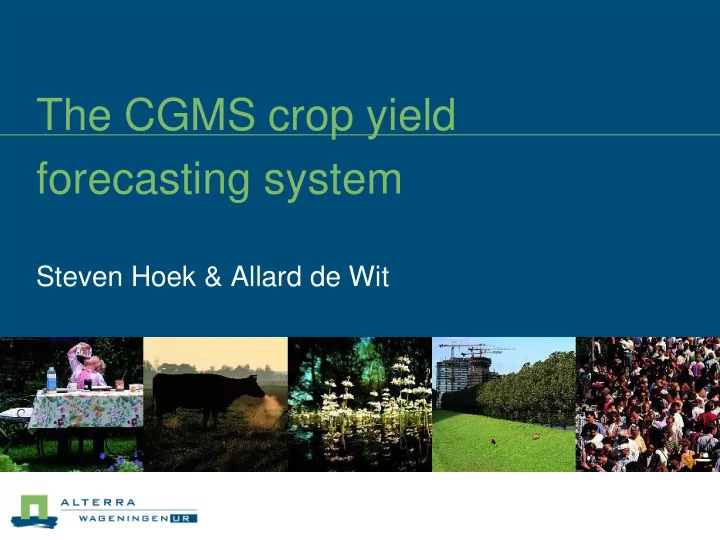

The CGMS crop yield forecasting system Steven Hoek & Allard de Wit
Introduction, part 1 WUR = Wageningen University & Research Centre Legal entity behind the research centre: Stichting DLO DLO is divided up into more than 5 institutes, including: Alterra (environmental science) Plant Research International (plant science), includes Biometris
Introduction part 2 Alterra: Centre for Geo-Information Centre for Water and Climate Centre for Soil Centre for Landscape Centre for Ecosystems
Contents Some background on crop yield forecasting Yield forecasting models The CGMS Statistical Toolbox (Crop Yield forecasting tool) demonstration Play around with the CGMS Statistical Toolbox
Goals Get to know yield forecasting concepts Become familiar with the CGMS yield forecasting tool Be able to carry out crop yield forecasts based on results from CGMS Be able to add your own indicators to the CGMS toolbox
About crop yield forecasting Estimates of crop yield or production for the current season before the harvest For administrative regions Often calibrated against past regional statistical data Continuous “assimilation” of data as the growing season progresses Improve accuracy during the growing season Better then a baseline forecast (i.e. average or trend)
About crop yield forecasting “the art of identifying the factors that determine the spatial and inter-annual variability of crop yields” (René Gommes, FAO 2003).
About those factors “ … AND IF IT GETS ENOUGH RAIN, AND SUN, AND IF IT ISN'T KILLED BY HAIL, AND IF IT ISN’T DAMAGED BY FROST, AND IF WE CAN GET IT OFF BEFORE IT’S COVERED BY SNOW, AND IF WE GET IT TO THE ELEVATORS, AND IF THE TRAINS ARE RUNNING, AND IF THE GRAIN HANDLERS AREN’T IN STRIKE, AND IF … “
Type of forecasting systems Judgement, based on stakeholders that reach consensus on the expected yield given all available information Statistical, based on functional relationships between a crop yield indicator and the crop yield statistics (e.g. time trend models and/or CGMS simulation result) Combinations of the above (European MARS system)
Novara on 27/ June 2007 – 4 th International Temperate Rice Conference Wageningen 19 October 2007 – 1 ° WIMEK workshop on Earth Observation and crop growth modeling MCYFS 10 10 Mixed system: Meteorological information Deterministic Agrometeo Statistical information Standard Supervised elaborations On-demand elaboration Statistical (extreme events information & critical condition) Analysts Yield estimate Robust science for policy making
Statistical forecasting assumptions Uses time-series of historic statistics and crop yield indicators Parameterizes a forecasting model explaining the relation using a best fit criterion (mean squared error) The model parameters are derived at several time steps during the growing season (i.e. each dekad) Forecast model is then applied in prognostic mode to forecast the current season’s yield
Parameterize the model in time or in space? Build a time-series model for one region and multiple years Build a spatial model for multiple regions and one year Combine the two above (even more difficult!)
Reasons for preferring a time-series model Several effects: Socio-economic factors differ between regions (example: Germany 7.24 ton/ha, Poland 3.44 ton/ha) . Crop yields often show an upward (or downward) trend over the years Simulated year-to-year variability in crop yield differs from variability in regional statistics.
Statistical forecasting models Parametric models: Regression analyses: (multiple -) regression between crop yield statistics and crop indicators Non-parametric models: Scenario analyses: Find similar years and use these to forecast Neural networks: train a neural network to recognize yield-indicator relationships
Time-series regression models for crop yield forecasting Basic assumptions: crop yield = f( time- trend + indicators(i1, i2, …) ) Uses (multiple) linear regression Advantages: Simple, understandable Hypothesis testing (statistical significance) Provides models with predictive power
Example of analysis for wheat in Morocco
1. Assessment of the data
2. Time-trend analysis Strange value, discarded!
3. Choose indicators
4. Correlation with indicators
5. Choose options for regression analysis
6. Select the best model
7. Analyse the model details
8. Analysis of residuals
9. Correct model by excluding one/more year(s) R 2 = 0.601
10. Build final model
11. Evaluate the model
12. Apply the forecasting model Our complete forecasting model is specified by: The time trend model + 1. A linear model which can be considered as a 2. model for yield anomalies as a function of the CGMS simulation results
13. Reported vs. fitted yields
14. Common pitfalls Take the time-window too large: unstable trend Use multiple linear regression with too many indicators (low DF): good fits but no predictive power Overlook collinearity Ignore non-statistical evidence that an outlier is indeed a bad value
Example of scenario analysis for wheat in Portugal
Scenario analysis
The CGMS statistical toolbox (CST) Observation: Manual analyses is error prone Desire by MARS-Stat for a dedicated tool for yield forecasting Development of CGMS Statistical Toolbox CST does several analyses: time trend analyses, (multiple) regression analyses and scenario analyses Each model is tested whether it improves prediction beyond the trend only Hypothesis testing for determining significance of results
Thank you Merci اركش Dankuwel Asante sana
Recommend
More recommend